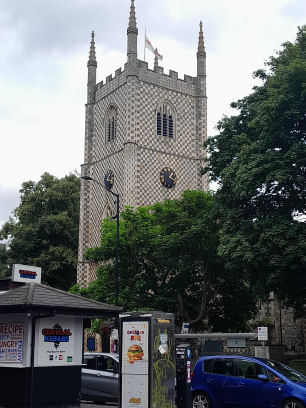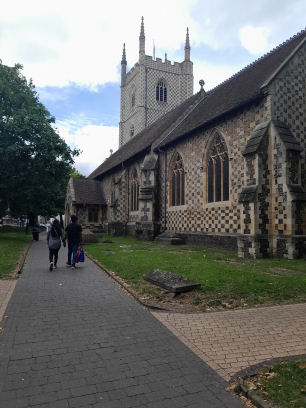





Reading ChurchesClick on a photo for a large version. |
Here are some churches in Reading. They tend to be built of flint, and Reading Abbey! (The stones got reused after the abbey was closed.) They also tend to be closed to the casual public.
Grade I - Reading Minster, or the Minster Church of St Mary the Virgin, is the oldest ecclesiastical foundation in the town of Reading, Berkshire, England. Although eclipsed in importance by the later Reading Abbey, Reading Minster regained its status after the destruction of the Abbey and is now an Anglican parish church. St Laurence's was one of the three original parish churches, along with St Mary and St Giles. Originally of C11 date and much enlarged and altered in the C16, C17, C19 and C20.
Grade I. St Laurence was one of the three original parish churches, along with St Mary's and St Giles', serving the medieval borough of Reading. It was next to Reading Abbey, but now Forbury Gardens lies in between. The church dates from the Norman period but underwent major rebuildings in the 15th century and in 1867.
As you can see from the first photo, St Laurence is next to the Town Hall. You can walk through the churchyard to get to Forbury Gardens.
The black and white building is 27 and 28, Market Place. It is listed grade II, Early C17, possibly older.
In February 1943, during WW2, two planes dropped bombs on Reading town centre. Part of the dislodged west window now lies in the graveyard.
There is also a wooden memorial to a railway worker who died in a whirlwind in 1841. The original board has been replaced (several times).
The Abbey hospitium can be seen from the churchyard.
In Friar Street, and the western end. Grade I. Oldest Franciscan church still in use as a place of worship in the UK, and is said to be the most complete surviving example of Franciscan architecture in England.
On Forbury Road. It can be seen from Forbury Gradens and from the Abbey. Grade II. "Roman Catholic 1837-40 by Augustus Welby Northmore Pugin. Untypical Norman style." (Pugin normally did Gothic, but he wanted it to fit in with Reading Abbey next door.) It is a Roman Catholic church.
Grade II. St Giles' was one of the three original parish churches, along with St Mary's and St Laurence's, serving the medieval borough of Reading. The church is on Southampton Street, just outside the town centre and in the portion of the original borough to the south of the River Kennet.
During the Civil War, when the Parliamentarian forces besieged Reading, the church tower was garrisoned by the King's forces and used as a gun platform. As a consequence it was in turn attacked by the besieging artillery and the upper part of the tower, including its spire, was destroyed in 1643. The fabric was restored at the end of hostilities.
Soldiers who died in the Battle of Reading during the Dutch invasion of England in the early part of the Glorious Revolution are buried here. The Battle of Reading took place on 9 December 1688. It was one of only two substantial military actions in England during the Glorious Revolution (the other being at Wincanton), and was a decisive victory for forces loyal to William III of Orange. The victory was celebrated in Reading for many years.
In 1798 there was a disagreement between members of the congregation of St Giles' Church. Many of them left and founded a new chapel in Castle Street, on the site of Reading's old gaol. This chapel eventually became the Church of St Mary, Castle Street.
In 1872, the original small mediaeval church was rebuilt by James Piers St Aubyn in Early English style retaining only the 13th century aisle walls and Perpendicular style west tower. A new ashlar steeple was added in 1873. The exterior of the church is faced in flint and the roof is tiled.
St Peter's, Caversham dates to 1162. Royalists stationed troops in St Peter's Church during the Siege of Reading in 1643, and situated a cannon on top of the church tower. The Parliamentarians used artillery to destroy the tower. The church itself was also damaged in the process.
This is next to Caversham Garden. It was open, unlike the churches in Reading!
© Jo Edkins 2024